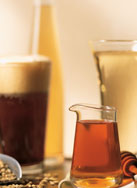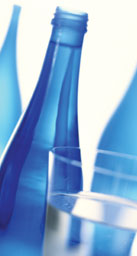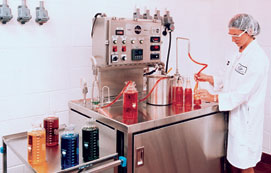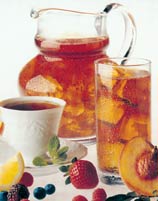
“It's not hard to add flavorings to a beverage and make it taste great, but you must carefully simulate your customer's processing conditions to make a good final product,” says Stephen Wolf, director of flavor applications for a flavor supplier.
Flavors do not perform the same in all beverage bases—they can taste very different from one base to another. Shelf life is another issue—over time, the flavor may increase or decrease in intensity or change character.
Flavoring beverages seems like a mysterious process at times; however, understanding a few ingredient basics goes a long way towards success.
Balancing Sweetness and Acidity
The ratio of sugars to acids plays a major role in beverage formulation. Balancing sweetness and tartness greatly affects the overall flavor profile. Acids add tartness to beverages as well as help boost flavor character and overall flavor perception. Commonly added acids include citric, malic, tartaric, and phosphoric. While citric acid is most commonly added to fruit-flavored drinks, phosphoric acid is added to most colas.Deciding on which sweetening system to use often is a factor of cost and labeling requirements. Sensory panelists describe sweetness profiles of beverages according to onset (how quickly sweetness is first sensed), build (time from sweetness onset to maximum sweetness intensity) and intensity (total sweetness). Each sweetener and sweetener blend has its own profile in different beverage bases and greatly impacts the overall flavor profile. For example, by altering various combinations of sweeteners, the flavor profile of a cola can shift from primarily a spicy blend to more of a citrus-dominated profile.
Some of the sweetening options include a choice of nutritive or non-nutritive (high intensity or low calorie) sweeteners. Commonly used sweeteners in beverages include dry sugar, liquid sucrose, and high-fructose corn syrup. Formulators in this country can choose from five high intensity sweeteners that are approved by the Food and Drug Administration (FDA): aspartame, acesulfame potassium (ace-K), sucralose, saccharin and, most recently (July 2002), neotame. Neotame has the highest sweetness potency with between 7,000 to 13,000 times the sweetness of sugar, making it 30 to 60 times sweeter than aspartame.
“Many beverage manufacturers are using sweetener blends—this is a good approach because many of the sweeteners have synergies and when used together, they round out each other's sweetness profiles,” says Wolf. For example, because ace-K's sweetness generally fades fairly quickly, it often is used in a blend with aspartame for longer-lasting sweetness.
Fruit juice concentrates add their own sweetness to beverages—as well as flavor and color. They are made by concentrating pressed juice with heat, vacuum evaporation or both. Sweetness varies between fruits and the percentage of sugar (°Brix) and pH of the juice concentrate.

The sugar/acid ratio of beverage bases plays a big role in the perception of fruit flavors. The ratio helps give the fruit its characteristic sweetness and tartness. Because the ratio varies with fruit maturity, a ripe fruit will have more sweetness and less acid than when the fruit is green or unripe.
For a more authentic flavor, acids that are contained in a fruit are added to a beverage. For example, malic acid comprises about 95% of the total acid content of apples, so this would be a good choice for apple-flavored drinks. Malic acid also occurs naturally at a high concentration in other fruits such as cherry, watermelon, banana, and peach. On the other hand, strawberries contain mostly citric acid and very little malic acid. By blending organic acids typically found in fruits, formulators can achieve flavor nuances.

Protein-Flavor Interactions
Anyone who has tried to flavor protein-based beverages, either soy- or dairy-based, has found that—in certain instances—the flavor seems to “disappear” or become altered in some way. Where does the flavor go?Some proteins and carbohydrates are known to bind flavors. The effect of flavor binding on perceived flavor intensity depends on the flavor molecule and the type, amount and composition of the protein, as well as the presence of ingredients such as lipids or polysaccharides.
“There are several issues with proteins and flavors—one is the taste of the protein itself and the other is how the protein interacts with the flavor,” states Danièle Karleskind, Ph.D., applications manager of protein products for an ingredients supplier.
For most protein-based beverages, either dairy- or soy-proteins are used in formulations. Various components of these matrices interact differently with flavor molecules. For example, previous researchers indicate the phospholipids content in protein can interact with flavors to alter their perception, says Karleskind.
Both soy protein concentrates (65% protein minimum), and soy protein isolates (SPI) (90% protein minimum), can possess undesirable raw/green, beany or cereal-like notes as well as an astringent mouthfeel. Lipid oxidation (rancidity) occurs during soybean processing to create off notes. It is very difficult to remove the oxidized compounds (lipoxygenases) that combine with proteins.
Chocolate has proven to be a popular flavor for soy-based beverages, due to its ability to mask protein flavor and provide a smooth flavor profile. Formulators have more difficulty getting subtle flavors such as vanilla and fruit flavors to come through.
Suppliers have been making progress towards creating blander bases. Karleskind's company is launching a new SPI in the beginning of next year. “The new SPI is very soluble and well-suited for beverages and has a blander flavor profile with less astringency and aftertaste,” she says.
Protein-flavor interactions are a hot topic that continues to spur research at both supplier companies and research institutions. Protein denaturation or the unfolding of the 3-dimensional protein structure resulting from chemical or heat, alters the binding sites for flavor molecules. Proteins can bind more or less of a flavor compound, depending on the amount of heat treatment.

In the area of milk proteins, researchers have been investigating protein-flavor interactions, especially with beta-lactoglobulin (BLG), the major protein of cow's milk whey. BLG is a much studied molecule, having its amino acid sequence and 3-D structure determined.
Protein-based beverages that are processed at high temperatures tend to bind more flavor, allowing less to be perceived. Studies with benzaldehyde (a key chemical compound in cherry and almond flavors) have shown the BLG portion of whey protein fraction unfolds with heating, allowing the flavor molecule to bind to the protein fraction and reduce the amount available for flavor perception.
“Beta-lactoglobulin is the only protein that we understand in any detail regarding flavor interactions,” says Gary Reineccius, Ph.D., professor of food chemistry in the Department of Food Science & Nutrition at the University of Minnesota. “We do not have this level of understanding with caseins, immunoglobulins, alpha-lactalbumin or soy proteins.”
Reineccius' own research group is developing analytical techniques to measure aroma release in the mouth during eating, as well as investigating the stability and perception of flavors. For beverage specialists and other technologists who want to learn more about flavors, Reineccius offers a series of four flavor workshops at the University of Minnesota campus: basic food flavor systems; food and beverage applications; off-flavors in foods; and instrumental analysis, encapsulation and reaction flavors. (Please see Website Resources below.)
Sidebar: Sweet Flavors
Honey is recognized for its sweetness and soothing properties. The National Honey Board is a research and promotion board that drives the demand for honey through marketing, research, advertising and promotion. The organization offers free consultation and development services for food processors seeking assistance utilizing this wonderful ingredient. National Honey Board, 800-553-7162, ext. 14,www.nhb.org,www.honeylocator.com
The International Pastry Concepts line of flavors includes: Baklava, Biscotti, Danish, Éclair, Elephant Ear Pastry, Macaroon, Raspberry Danish and Tiramisu. When formulated into applications such as yogurts, beverages or snack bars, adventurous consumers will be intrigued by the use of Robertet Flavors Inc.'s gourmet pastry flavor concepts in non-traditional product categories. Robertet Flavors Inc., Gretchen Schleck, 732-981-8300
Using the unique properties of licorice, MAFCO has developed the Magnasweet line of products. These multifunctional flavor enhancers, sweetness potentiators and masking agents are designed to meet the diverse needs of the food industry. MAFCO Worldwide Corp. is recognized as a leading manufacturer of licorice products. MAFCO Worldwide Corp, Joe Olesiewicz, 856-968-4062, jolesiewicz@mafcolicorice.com
This company manufactures numerous sweet and nut flavors including chocolate, brown sugar, caramel, condensed milk, and cocoa distillates. David Michael provides nut flavors ranging from walnut to pistachio to hazelnut. Additionally, it offers sweetness enhancers and nut flavor extenders. David Michael & Co., 800-DMFLAVORS (ask for the TCS dept.), dmflavor@dmflavors.com
In response to the ongoing trend towards brown and warm flavors, Ottens Flavors is featuring a line of sweet flavors including Pumpkin Pie Spice. The Pumpkin Pie Spice flavor contains a typical blend of cinnamon, clove, nutmeg and ginger and has been used in beverages, baked goods, bars and confections. Ottens Flavors, Kelly DeFusco, 215-365-7800, kelly.defusco@ottens.com
The most popular cinnamon flavors offered by Comax Flavors are the Cinnamon Sweet Bakery Type, Cinnamon Bun Type, Cinnamon Toast, and Ground Cinnamon. This new line is formulated for use in baked products, cereals, snacks, candies and yogurt. The line is available in natural, natural and artificial, or synthetic formulation; liquid, powder or spray-dried forms, in water-soluble or oil-soluble formats. Samples and technical data are available. Comax Flavors, Norman Katz, 800-992-0629, info@comaxflavors.com

Candies, cookies and confections taste better when they are made with vanilla. The full, mellow flavor of pure vanilla rounds out the sweet flavors of cream and sugars and complements inclusions such as nuts. Nielsen-Massey Vanillas, 800-525-7873 (PURE), www.NielsenMassey.com
These honey granules are free-flowing and relatively non-hygroscopic ingredients, which provide increased production and handling ease. With less than 1.5% moisture content, Qwik-Flo® Honey Granules result in products that have an excellent shelf life and do not support microbial growth. The product is 100% natural dry honey with no artificial additives. Domino Specialty Ingredients, David Poust, 800-446-9763, specialty.ingredients@dominofoods.com, www.dominospecialtyingredients.com
New flavors that can be used in applications such as hard candy, gum drops, cream centers, jelly candy and chocolate are an extension of the SUPERFEX® line of flavors. At this time, the line contains 225 different flavors. Please contact the company for a complete list. Virginia Dare, 718-768-3978, flavorinfo@virginiadare.com
A trouble-free confectioner's coating can be achieved. Tem Cote is a product that may be used in the manufacture of both chocolate and pastel compound coatings. Coatings made with Tem Cote resist softening, cracking and scuffing, and also prevent the transfer of moisture. In addition to candy, Tem Cote can be used in doughnuts, soft cakes and other bakery items. Bunge Foods, 800-828-0800, www.bungefoods.com

Sidebar: Juices that Sparkle
The Switch from Switch Beverage Co., Richmond, Va., is marketing a line of carbonated juice beverages containing 100% juice, natural flavors and no added sugar or preservatives. Each beverage contains 100% RDI for vitamin C and comes in five flavors that include: Orange Tangerine, Apricot Peach, Citrus Blend, Fruit Berry, and Watermelon Strawberry.The beverages are made with fruit juice concentrates and carbonated water. The Orange Tangerine, Apricot Peach and Watermelon Strawberry contain white grape and apple juice concentrates blended with concentrates from the named juices as well. Citrus Blend is a blend of white grape, grapefruit, orange, lime, and lemon juice concentrates.
“We are taking the 'less is more' approach and found that the fruit juice concentrates provided us with enough sweetness in the beverages,” says Bill Hargis, president and CEO of Switch Beverage.
Various parameters were key in formulating a tasty sparkling juice beverage. The higher the carbonation, the less sweetness is perceived. For this reason, the juices are lightly carbonated.
Orange Tangerine is the number one seller, says Hargis. The latest flavor to roll out is a sparkling lemonade. Future flavors include Cranberry Ginger.
Hargis found out that naming a product is a key component to its success. “We originally called the Citrus Blend 'Grapefruit Citrus.' We found out that consumers have very strong opinions about grapefruit—mostly negative. When we renamed the product and eliminated the word 'grapefruit' from the title, our sales doubled.”
For more information:
Flavor-Food Interactions, edited by Robert J. McGorrin and Jane V. Leland
ACS Symposium Series 633; 1996.